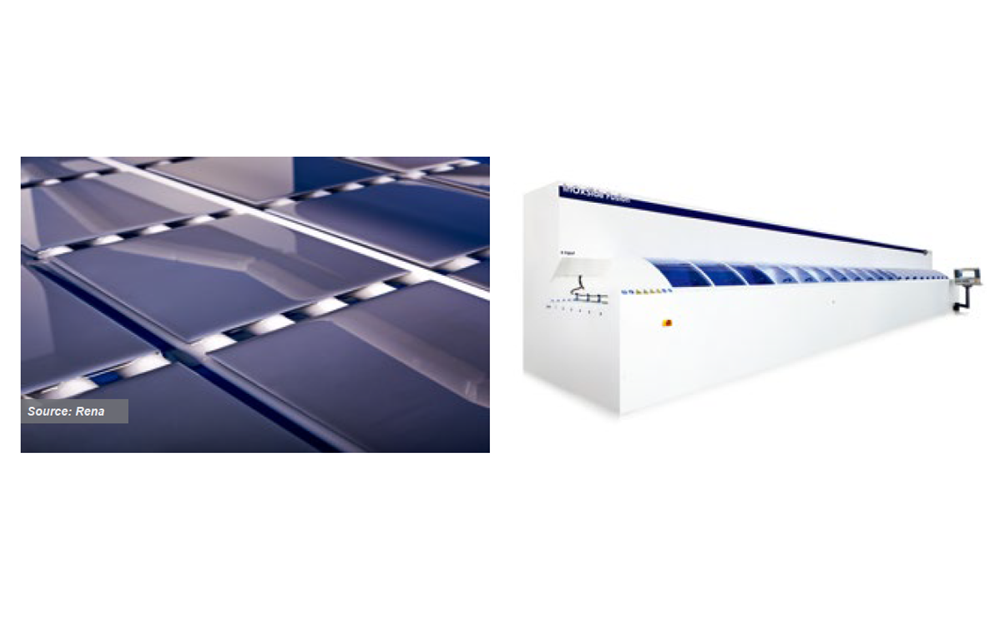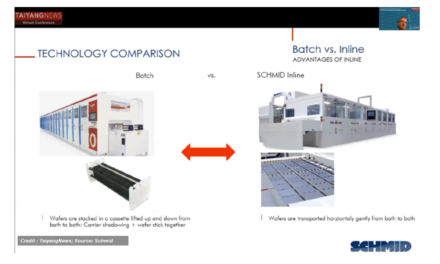- PSG etch and edge isolation are two other important applications of wet benches (apart from texturing) in solar cell processing
- These tools are also optimized for rear polishing
- While acidic solutions are usually used for this application, using an alkaline chemistry is the latest trend
- Shifting to alkaline chemistry not only helps in reducing costs but also improves process efficacy
Solar cell emitter formation has 2 undesired outcomes – formation of phosphorus silicate glass (PSG) and an emitter formed on both sides of the wafer along the wafer rims. Thus, PSG etch and edge isolation are 2 other important applications of the wet-benches post emitter formation. The PSG is removed with diluted HF solution, and doping on the rear side is removed with slight etching on the rear. These 2 steps are accomplished in one go, typically in an inline fashion using HF and HNO3. German company Schmid has an interesting technology on offer that protects the emitter during the rear etching by making the rims hydrophobic. In this way, the protective layer of water present on the emitter side is prevented from spilling.
These wet benches also play an important role in PERC where the rear surface needs to be polished. Typically, PSG etch and edge isolation tools, which anyway etch the rear surface, are tweaked to accomplish this. Equipment suppliers are developing special versions of their tools, making them longer and affording greater flexibility with respect to the degree of rear polishing (see Dry Etching For Texturing).
While acidic solutions are usually used for this application, using an alkaline chemistry is the latest trend. Rena has developed a tool platform called InOxSide 3+ Fusion that still uses acidic pre-etching, combined with alkaline final polishing. Cost reduction is the major motivator here, according to German company RENA’s SVP technology and innovation Holger Kuehnlein. The acidic process using HF/HNO3 is expensive not just because of the chemicals themselves, but their disposal is a costly affair as well. Replacing the acidic chemistry with alkaline is one way to reduce costs.
The tool, though about 50% larger compared to the acidic line, offers great flexibility to adjust the rear surface morphology with variable degrees of polishing. On top, RENA has also added an additional cleaning section that is based on ozone. As a result, the machine consists of 4 sections in total — an acidic section for emitter etching, a polishing section, a PSG etching and a cleaning section. This approach has led to 70% reduction in HNO3 consumption as of now, according to Kuehnlein. In his presentation he even showed a comparison analysis of polishing processes based on acidic and alkaline solutions. The roughness that can be achieved with 6 μm etching using acidic solutions, which is already deep etching, is not even at the level of what is possible with 2 μm deep combined etching. He further added that there are more than 75 tools right now out in production that have shown a gain of more than 0.1% efficiency based on the concept and the tool configuration. To explain it in absolute terms, against a reference efficiency of 23.01% with the acidic process, the fusion process alone improves it to 23.05%, while adding the ozone cleaning boosts it to a level higher to 23.12% (see Tools For Solar Wafer Texturing).
Extending the fusion platform further, RENA has built another new tool configuration called InOxSide 3+ Blue, where the “Blue” suffix stands for eliminating the HNO3 completely. The process, however, involves the use of HF in small quantities in the form of preconditioning for glass removal. While the first machine was shipped out in Q4/2021, Rena is planning to start selling to the open market in Q2/2022. Encouraged with achieving an ultimate efficiency of 23.3%, Rena is further optimizing the hardware and the process itself. Kuehnlein is confident of reaching 23.7% efficiency with the line. He also presented a sheet comparing costs that ultimately showed that both the latest solutions of the company have the lowest cost of ownership.
Costs table Rena
At the tool level, both InOxSide 3+ Fusion and InOxSide 3+ Blue have the same throughput of 5,400 wafers per hour referring to M6 and 5,000 when processing M10/G12. Apart from these 2, RENA is also promoting 2 more tools in this section — InOxSide 3+ Acidic and InEtchSide 3+. As the name suggests, the former uses acidic solutions for single side etch and PSG removal, while the latter is a high throughput single side glass etching tool capable of processing up to 7,200 wafers of M10 or G12 sizes.
RENA’s development over years have dramatically decreased the cost of ownership for its InOxSide solutions (Source: RENA; Graphic: ©TaiyangNews 2022).
Schmid has been a longtime advocate of alkaline polishing tools. One of its two models promoted for this application eliminates the use of HNO3, which Schmid’s Technology VP Christian Buchner estimates to reduce the costs by 30 to 40% on the whole, and the environmental benefit being the icing on the cake. Schmid also, however, offers a variant based on acidic chemistry. Both the tools are rated with the same maximum throughput of 7,000 wafers per hour. S.C New Energy is also offering 2 tools – one acidic and the other alkaline based – while PSG removal is the common step. The system configurations are quite different, however. While the tool using acidic polishing reaches a throughput of 4,700 wafers per hour, the alkaline one supports 8,500 wafers per hour. Another Germany company, exateq is offering only a glass etching tool that is designed to use HF and reaches very high throughput of 12,000 wafers per hour.
The Text is an excerpt from TaiyangNews recent report on PERC Cell Production Equipment 2022, which can be downloaded for free here.
















